
Moderators: Elvis, DrVolin, Jeff
Eyewitness to the Israeli Assault on the Mavi Marmara
By DAVE LINDORFF
Kevin Neish of Victoria, British Columbia, didn’t know he was a celebrity until he was about to board a flight from Istanbul to Ottawa. “This Arab woman wearing a beautiful outfit suddenly ran up to me crying, ‘It’s you! From Arab TV! You’re famous!’” he recalls with a laugh. “I didn’t know what she was talking about, but she told me, ‘I saw you flipping through the Israeli commando’s book! It’s being aired over and over!’”
A soft-spoken teacher and former civilian engineer with the Canadian Department of Defense, Neish realized then that a video taken by an Arab TV cameraman in the midst of the Israeli assault on the Freedom Flotilla to Gaza of him flipping through a booklet had been transmitted before the Israelis blocked all electronic signals from the flotilla. The booklet had pictures and profiles of all the passengers, and he'd found it in the backpack of an Israeli Defense Force commando.
Neish, 53, was on the second deck of the flotilla’s lead ship, the Turkish Mavi Marmara, with a good view of the stern, when the IDF, in the early morning darkness of May 31, began its assault with percussion grenades, tear gas and a hail of bullets. He then moved to the fourth deck in an enclosed stairwell, from which he watched took photographs as casualties were carried down past him to a makeshift medical station. Several IDF commandos, captured by the passengers and crew, were also brought past him.
“I saw them carrying this one IDF guy down,” he recalls. “He looked terrified, like he thought he was going to be killed. But when a big Turkish guy, who had seen seriously injured passengers who had been shot by the IDF, charged over and tried to hit the commando, the Turkish aid workers pushed him off and pinned him to the wall. They protected this Israeli soldier.”
That was when he found the backpack which the soldier had dropped. “I figured I’d look inside and see what he was carrying,” Neish says. “And inside was this kind of flip-book. It was full of photos and names in English and Hebrew of who was on all the ships. The booklet also had a detailed diagram of the decks of the Mavi Marmara.”
Meanwhile, he says, more and more people were being carried down the stairs from the mayhem above—people who'd been shot, and people who were dying or people already dead. “I took detailed photos of the dead and wounded with my camera,” he says, adding, “There were several guys who had two neat bullet holes side by side on the side of their head--clearly they were executed.”
Neish smuggled his photos out of Israel to Turkey despite his arrest on the ship and imprisonment in Israel for several days. “I pulled out the memory card, tossed my camera and anything I had on me that had anything to do with electronics, and then kept moving the chip around so it wouldn’t be found,” he says. “The Israelis took all the cameras and computers. They were smashing some and keeping others. I put the chip in my mouth under my tongue, between my butt cheeks, in my sock, everywhere, to keep them from finding it,” he says. He finally handed it to a Turk who was leaving for a flight home on a Turkish airline. He says the card ended up in the hands of an organization called Free Gaza, and he has seen some of his pictures published, so he knows they made it out successfully.
Neish says that claims that the Israeli commandos were just armed with paint guns and 9 mm pistols are “Bullshit--at one point when I was in the stairwell, a commando opened a hatch above, stuck in a machine gun, and started firing. Bullets were bouncing all over the place. If the guy had gotten to look in and see where he was shooting, I’d have been dead, but two Turkish guys in the stairwell, who had short lengths of chain with them that they had taken from the access points to the lifeboats, stood to the side of the hatch and whipped them up at the barrell. I don’t know if they were trying to hit the commando or to use them to snatch away the gun, but the Israeli backed off, and they slammed and locked the hatch.”
“I never saw a single paint gun, or a sign of a fired paint ball!” he says.
He also didn't see any guns in the hands of people who were on the ship. “In the whole time I was there on the ship, I never saw a single weapon in the hands of the crew or the aid workers,” he says. Indeed, Neish, who originally had been on a smaller 70-foot yacht called the Challenger II, had transferred to the Mavi Marmara after a stop in Cyprus, because his boat had been sabatoged by Israeli agents (a claim verified by the Israeli government), making it impossible to steer. “When we came aboard the big boat, I was frisked and my bag was inspected for weapons,” he says. “Being an engineer, I of course had a pocket knife, but they took that and tossed it into the ocean. Nobody was allowed to have any weapons on this voyage. They were very careful about that.”
What he did see during the IDF assault was severe bullet wounds. “In addition to several people I saw who were killed, I saw several dozen wounded people. There was one older guy who was just propped up against the wall with a huge hole in his chest. He died as I was taking his picture.”
Neish says he saw many of the 9 who were known to have been killed, and of the 40 who were wounded, and adds, “There were many more who were wounded, too, but less seriously. In the Israeli prison, I saw people with knife wounds and broken bones. Some were hiding their injuries so they wouldn’t be taken away from the others.” He also says, “Initially there were reports that 16 on the boat had been killed. The medical station said 16. There was a suspicion that some bodies may have been thrown overboard. But what people think now is that the the other seven who are missing, since we’re not hearing from families, may have been Israeli spies.”
Once the Israeli commandos had secured control of the Mavi Marmara, Neish says the ship’s passengers and crew were rounded up, with the men put in one area on deck, and the women put below in another area. The men were told to squat, and had their hands bound with plastic cuffs, which Neish says were pulled so tight that his wrists were cut and his hands swelled up and turned purple (he is still suffering nerve damage from the experience, which his doctor in Canada says he hopes will gradually repair on its own).
“They told us to be quiet,” he says. “But at one point this Turkish imam stood up and started singing a call to prayer. Everybody was dead quiet--even the Israelis. But after about ten seconds, this Israeli officer stomped over through the squatting people, pulled out his pistol and pointed at the guy’s head, yelling ‘Shut up!’ in English. The imam looked at him directly and just kept singing! I thought, Jesus Christ, he’s gonna kill him! Then I thought, well, this is what I’m here for, I guess, so I stood up. The officer wheeled around and pointed his gun at my head. The imam finished his song and sat down, and then I sat down.”
While the commandeered vessels were sailed to the Israeli port of Ashdot, the captives were left without food or water. “All we were given were some chocolate bars that the Israelis pilfered from the ship’s stores,” says Neish. “You had to grovel to get to go to the bathroom, and many people had to just go in their pants.”
Things didn’t get much better once the passengers were transferred to an Israeli prison. He and the other prisoners with him, who hadn’t eaten for more than half a day, were tossed a frozen block of bread and some cucumbers.
On the second day, someone from the Canadian embassy came around, calling out his name. “It turned out he’d been going to every cell looking for me,” says Neish. “My daughter had been frantically telling the Canadian government I was in the flotilla. Even though the Israelis had my name and knew where I was, they weren’t telling the Canadian embassy people. In fact the Canadians--and my daughter--thought I was dead, because people had said I’d been near the initial assault. The good thing is that as they went around calling out for me, they discovered two Arab-born Canadians that they hadn’t known were there.”
“Eventually they got to my cell and I answered them. The embassy official said, ‘You’re Kevin? You’re supposed to be dead.’”
After being held for a few days, there was a rush to move everyone to the Ben Gurion airport for a flight to Turkey. “It turned out that Israeli lawyers had brought our case to the Supreme Court, challenging the legality of our capture on international waters. There was a chance that the court would order the IDF to put us back on our ships and let us go, so the government wanted to get us out of Israel and moot the case. But two guys were hauled off, probably by Mossad (the Israeli intelligence agency). So we all said, ‘No. We don’t go unless you bring them back.’”
The two men were returned and were allowed to leave with the rest of the group.
“I honestly never thought the Israelis would board the ship,” says Neish. “I thought we’d get into Gaza. I mean, I went as part of the Free Gaza Movement, and they had made prior attempts, with some getting in, and some getting boarded or rammed, but this time it was a big flotilla. I figured we’d be stopped, and maybe searched. My boat, the Challenger II, only had dignitaries on board including three German MPs, and then Lt. Col. Ann Wright and myself.
At one point in the Israeli prison, all the violence finally got to this man who had witnessed more death and mayhem than many active duty US troops in Iraq or Afghanistan. “I broke down and started crying,” he admits. “This big Turkish guy came over and asked me, ‘What’s wrong?’ I said, ‘Sixteen people died.’”
“He said to me, ‘No, they died for a wonderful cause. They’re happy. You just go out and tell your story.’"
http://www.counterpunch.org/lindorff06162010.html

“I never saw a single paint gun, or a sign of a fired paint ball!” he says.
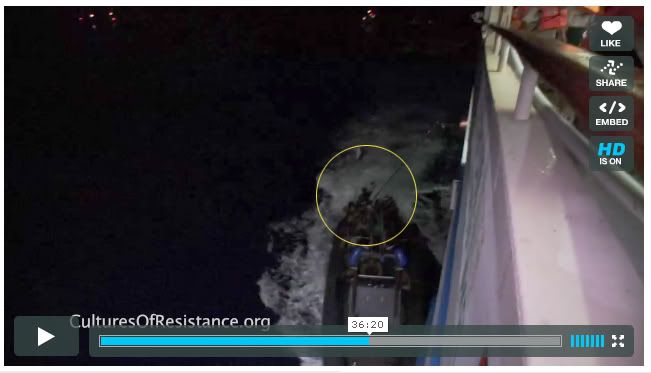

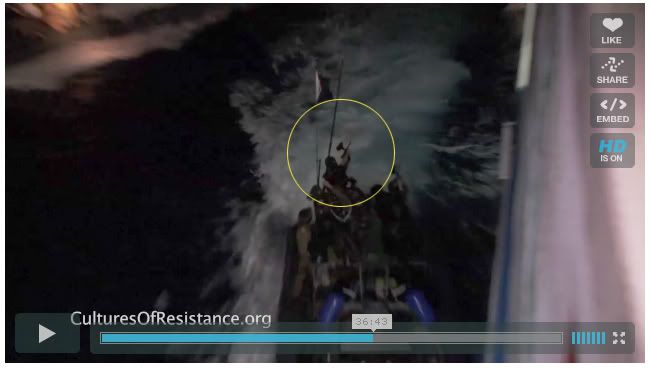

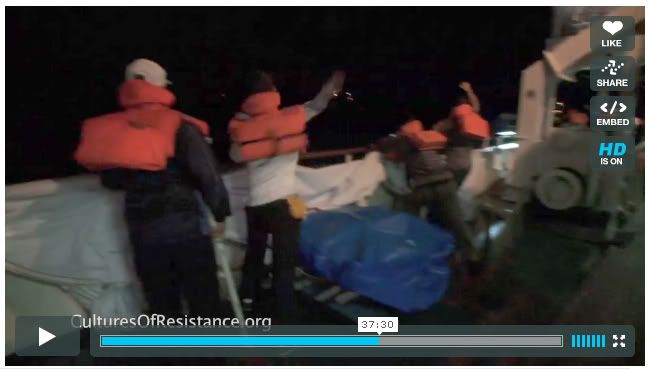
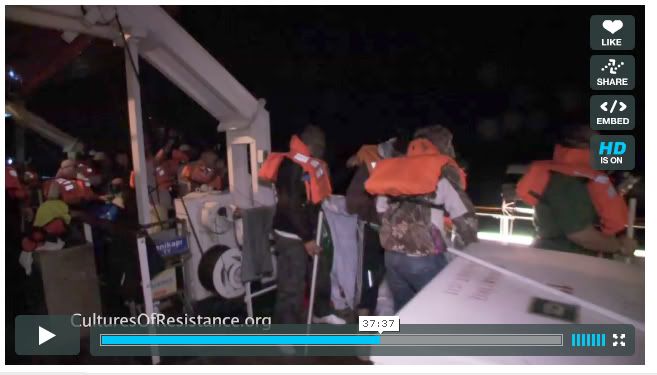
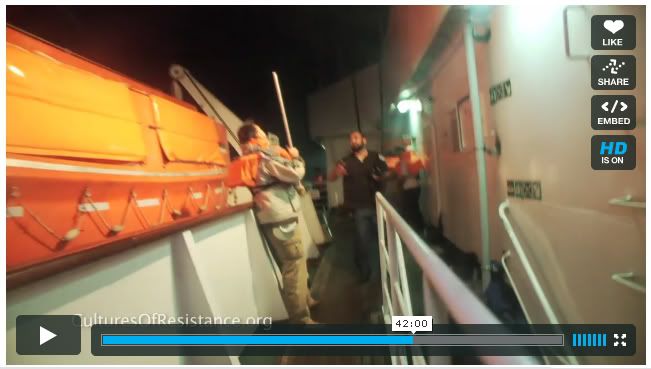

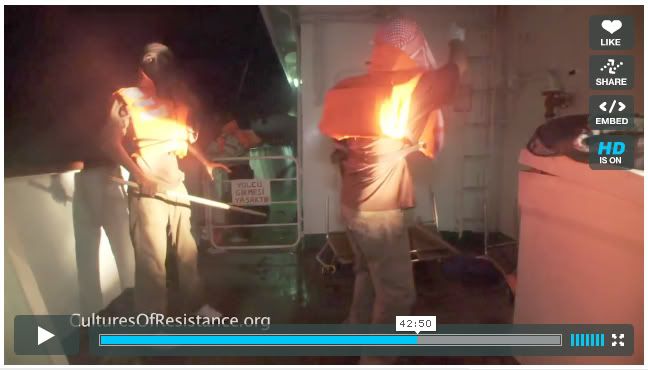
Neish says that claims that the Israeli commandos were just armed with paint guns and 9 mm pistols are “Bullshit--at one point when I was in the stairwell, a commando opened a hatch above, stuck in a machine gun, and started firing. Bullets were bouncing all over the place.
A U.S. Navy fleet is moving through the Suez Canal into the Red Sea, probably aiming to head off the Iranian flotilla headed toward Gaza.
Anchors aweigh. The United States Navy is sending an aircraft carrier and nearly a dozen other warships through the Suez Canal and into the Red Sea, according to the British Arabic Language newspaper Al-Quds Al-Arabi, which reported that the ships carry infantry troops, armored vehicles, and ammunition.
The report was taken very seriously in Israel, where two major newspapers gave it headline coverage -- perhaps because the U.S. fleet is joined by at least one Israeli ship, according to eyewitnesses who saw it pass through the Canal.
Iran’s Press TV claims that the Defense Department has confirmed the movement of American ships. However, neither the U.S. nor the Israeli governments have made any statement about the fleet’s destination or purpose. So we’re left to speculate.
Can it be just coincidence that this is happening precisely when “two Iranian vessels are due to set sail for Gaza in the coming week,” according to Al Jazeera, sponsored by the Iranian Red Crescent, carrying food, medicine, and clothing? And when Iran is promising more aid flotillas after this first one?
When the Iranian flotilla was first announced, State Department spokesman Philip Crowley said: "I don't think that Iran's intentions vis-a-vis Gaza are benign." Since then, the U.S. has remained silent.
Newsweeks.com’s Mark Hosenball says he has talked with U.S. and European officials and found them “surprisingly relaxed” about the Iranian challenge to Israel’s blockade of Gaza. They told him that “Tehran actually seems to have dialed back some of its rhetoric and threats for the moment,” and pointed out that the Navy is the weakest arm of Iran’s military.
But if U.S. officials are so relaxed, why spend a fortune (and it does cost a fortune) to move a whole war fleet including an aircraft carrier into the Red Sea and perhaps further, to the Persian Gulf -- where Israeli nuclear submarines are also headed?
Egypt, which controls the Canal, has a central role to play in this drama. Egyptian troops guarded the Canal, which was closed to other traffic, while the U.S. fleet passed through, despite criticism from leaders of Egyptian opposition parties.
It remains unclear how the Egyptians would deal with the Iranian aid ships. Those ships plan to pass through the Canal and then stay close enough to shore to be in Egyptian waters until reaching the area off the Gaza coast, which Israel claims as its territorial waters.
Israel radio has reported that Cairo rejected an Israeli request by for Egypt to block the Iranian ships, claiming that under international law the canal must be free to all ships. However, the Egyptians could delay the Iranians on technicalities for a long time.
Iranian officials have denied a report that their naval forces would escort the ships. “But if and when the Iranian ship reaches the Mediterranean,” as Hosenball says, “no one can be sure what will happen.” However we can be sure that an Iranian ship approaching Gaza would be a major crisis for both the Netanyahu government in Israel and the Obama administration. Very likely, the U.S. administration hopes that its war fleet, accompanied by a token Israeli ship for symbolic value, will head off the need to face that crisis.
The Israeli Media’s Flotilla Fail
On 06.22.10, By Max Blumenthal
My summary of the Israeli media’s shambolic performance following the flotilla massacre was originally published here in Hebrew at Dvorit Shargal’s excellent Israeli media blog, Velvet Underground. The English version follows:
If the raid of the Gaza Freedom Flotilla was a disaster for the Israel Defense Forces, its aftermath demonstrated an equally bewildering performance by the Israeli media. The IDF Spokesman’s Office churned out one misleading claim after another, each one more implausible than the next, seeking to implant in the public’s mind a version of events that bore little relation to reality. To a degree, this was to be expected; but it was startling to see how some of Israel’s most respected reporters lined up to serve as military stenographers, barely challenging the IDF’s rapidly changing versions of events. IDF claims about the flotilla passengers’ links to Al Qaida, anti-Semitic statements shouted at the Israeli Navy, and their terrorist intentions were eagerly broadcast by the Israeli media without a second thought. When independent reporters forced the IDF to retract or “clarify” all of these claims, Israeli news outlets refused to correct their errors, or covered them up without acknowledgment.
It so happened that I arrived in Israel for a research trip the day after the flotilla raid. As a result, I was able to do something which I always thought to be a very basic journalistic practice, so basic it’s supposed to be applied routinely: Asking an implicated party in a story to produce evidence for its claims. What I found bewildering is that at least judging from Israeli media reports, few, if any, mainstream reporters applied this practice, and when a visiting colleague did their job for them – nobody bothered to correct or withdraw their original report.
On June 2, the IDF disseminated a press release entitled, “Attackers of the IDF soldiers found to be Al Qaeda mercenaries.” The accusation was not accompanied by any conclusive evidence — the IDF reported that Mavi Marmara passengers were equipped with night-vision goggles (gasp!). This did not stop Yedioth’s Ron Ben-Yishai, who was embedded with the Navy commandos, from amplifying the baseless charge. Citing an “interrogation” of Marmara passengers — “lynchers,” he called them — Ben-Yishai wrote the same day, “Some among the [flotilla passengers] are believed to have ties with World Jihad groups, mainly Al Qaeda.” The article made no reference to any efforts on part of Ben Yishai to investigate this claim, nor did he seem to think to ask why the IDF was about to release dangerous operatives of Osama Bin Laden — presumably they would attack again, wouldn’t they?
On June 3, Israeli journalist Lia Tarachansky of the Real News Network and I placed calls to the IDF Spokesman’s Office to demand further evidence of the Marmara’s Al Qaeda ties. We received identical responses from spokespeople from the IDF’s Israel and North America desks: “We don’t have any evidence. The press release was based on information from the National Security Council.” Hours later, the IDF retracted its claim, changing the title of its press release to, “Attackers of IDF Soldiers Found Without Identification Papers.” Despite the official retraction, Ben-Yishai’s article remains uncorrected.
On June 4, the IDF released an audio clip purporting to consist of transmissions between the Mavi Marmara and a Naval warship. “Go back to Aushwitz!” a Marmara passenger shouted, according to the IDF. YNet and Haaretz reported on and reproduced the audio clip without investigating its authenticity. Forget that the voice uttering the anti-Semitic slur sounded like a mentally disturbed teenager; had reporters performed a cursory search of the IDF Spokeman’s Office website, they would have found a longer clip released on May 31 that featured a dramatically different exchange with the Marmara with no mention of Auschwitz. Further, the voice of flotilla organizer Huwaida Arraf was featured in the “Aushwitz” clip, yet Arraf was not aboard the Marmara (she was on the Challenger One). Could the IDF have doctored audio to exploit public hysteria surrounding the issue of anti-Semitism?
On my blog, I pointed out the discrepancies in the IDF’s footage and raised the question of doctoring. The next day, the IDF conceded that it had in fact doctored the footage, releasing a “clarification” and a new clip claiming to consist of the “full” exchange between the Navy and the flotilla. Unfortunately, the authenticity of the new clip was impossible to verify.
Despite the IDF’s admission, YNet and Haaretz have not corrected their original reports, though Haaretz has at least altered its headline. Once the doctoring was exposed, the New York Times covered the episode in detail, directing international attention to the triumph of independent online reporting and the apparent failure of Israel’s parochial press corps.
On June 7, Haaretz’s Anshel Pfeffer reported on an IDF press release claiming without evidence that five flotilla passengers had links to international terror. The press release was larded with highly implausible claims, including that Ken O’Keefe, who runs an aid organization with Tony Blair’s sister-in-law, was planning to train a Hamas commando unit in the Gaza Strip. When I called the IDF Spokesman’s Office, I learned that once again, no evidence was available to support their press release. “There is very limited intelligence we can give in this specific case,” Sgt. Chen Arad told me. “Obviously I’m unable to give you more information.” Did Pfeffer demand more evidence? If he did and was answered in the same manner as I did, why did Haaretz publish an unsubstantiated spin as fact?
Joined by Haaretz military correspondents Avi Isacharoff and Amos Harel, Pfeffer became a channel for another daytime deception by the IDF. On May 31, the three reporters produced an article based exclusively on testimony from Naval commandos — the flotilla passengers’ side of the story was ignored — claiming they had faced live fire and lynching attempts from Marmara passengers. Since the story was published, the IDF has produced scant evidence to support either accusation. The article was accompanied by a suspicious photo from the IDF Spokesman’s Office depicting a bearded Muslim man brandishing a knife and surrounded by photojournalists. Daylight beamed in from a window behind the man. Haaretz’s caption, which was sourced to the IDF, asserted that the photo was taken “after” the commandos had boarded the Marmara. However, the commandos raided the ship at night, while the photo was taken during the day. Once again, the IDF’s story was fishy.
I called Sgt. Arad at the IDF Spokesman’s Office to investigate. He told me he had no evidence to support the photo’s questionable caption. Soon after our phone conversation, Haaretz quietly altered the caption, removing its claim that the photo was taken “after” the commando raid. For nearly a week, the false photo caption had remained intact. Why did Haaretz suddenly change it? The only plausible explanation is that the paper received a tip from the IDF Spokesman’s Office. If true, the tip-off suggests a scandalous level of coordination between the Israeli military and the country’s media.
In the wake of the flotilla raid, Israeli journalists had a unique opportunity to lead the global media’s investigation into the bloodbath that occurred on the deck of the Mavi Marmara. After all, no one had better access to the military or the eyewitnesses aboard the flotilla. Instead, too many among the Israeli press corps allowed themselves to be conscripted into the IDF’s hapless information war, leaving the important task of investigating the raid to independent reporters who remembered to view claims by any nation’s military with extreme skepticism.
So why do well-connected, experienced reporters follow the IDF baton so willingly, and fail to follow up when IDF claims are retracted? Is it simple bias, a desire to present their military in the best possible light, a desire so strong they abandon their duty to their readers to verify their information? Are they afraid of sanctions, of losing contacts and access to information? Do they fear personal reprisals? Their readers, and the world media that still relies on Israeli journalism as a vital source of information, need to know.
http://maxblumenthal.com/2010/06/the-is ... illa-fail/
Organizers cite 'Israeli threats' as the reason for canceling the flotilla; separate Iranian ship heads to Gaza via Caspian Sea.
By Haaretz Service
One of the organizers of an Iranian aid flotilla that was to said to Gaza in efforts to break Israel's naval blockade on the territory, announced Thursday that the event has been cancelled due to "Israeli threats."
Army Radio reported that a separate Iranian ship, carrying 60 Iranian activists, was being prepared to sail to Gaza via the Caspian Sea. This after the Lebanese media reported several days ago that Egypt has denied Israel's request to prevent Iranian ships from passing through the Suez Canal toward Egypt.
Meanwhile Thursday, the U.S. State Department issued a statement calling the aid flotillas to Gaza irresponsible.
"Mechanisms exist for the transfer of humanitarian assistance to Gaza by member states and groups that want to do so," the U.S. State Department said regarding Lebanese plans to ship aid to Gaza. "Direct delivery by sea is neither appropriate nor responsible, and certainly not effective, under the circumstances."
The Lebanese and Iranian efforts come after a tragic incident aboard a Turkish aid ship, part of an 8-ship Turkish flotilla, which was headed for Gaza on May 31. Israeli navy commandos, intent on preventing the ship from reaching Gaza's shore, boarded the ship, and were met by a violent mob wielding sticks and knives. The clash that ensued resulted in the deaths of nine Turkish activists.
Users browsing this forum: No registered users and 23 guests